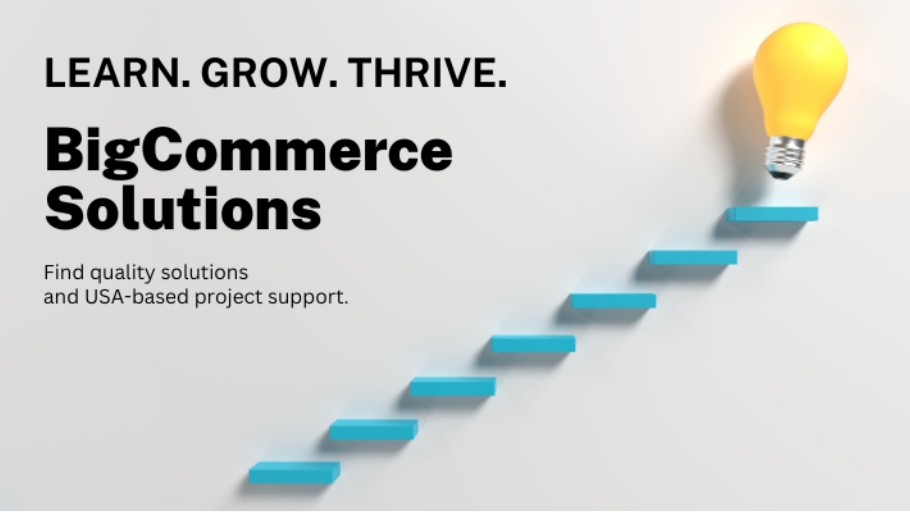Diving into the world of e-commerce can feel like navigating a labyrinth, especially if you’re new to the game. But here’s where it gets exciting: implementing BigCommerce doesn’t have to be a head-scratcher. This guide is your flashlight in the dark, illuminating step-by-step processes and best practices for setting up your online store without breaking a sweat. Forget about wading through complex technical jargon; we’re talking straight talk, actionable tips, and insider insights to get your shop live and kicking. Ready to turn that digital dream into reality? Let’s roll up our sleeves and dive in.
Selecting the Right Ecommerce Platform
Platform Scalability
Choosing an ecommerce platform requires thinking about future growth. A small startup will have different needs compared to a large enterprise. Assess if the platform can handle increased traffic and sales volume as your business grows.
For instance, BigCommerce is known for its scalability, making it a good choice for businesses planning to expand. It supports businesses of all sizes without compromising on speed or uptime.
Built-in Features
Evaluating built-in features against plugin requirements is crucial. Some platforms offer extensive features out-of-the-box, while others require additional plugins for full functionality.
BigCommerce comes with a wide range of built-in features like SEO tools and payment gateways. This reduces the need for external plugins and simplifies management. However, unique needs might still necessitate specific plugins.
Ease of Use
The simplicity of setting up and managing your online store cannot be overstated. Platforms that are easy to use save time and reduce frustration.
BigCommerce boasts an intuitive interface that’s friendly even to those new to ecommerce. Consider customer support options available for when you run into issues.
- Evaluate how user-friendly the platform’s dashboard is.
- Check if there are helpful guides or tutorials.
- Look into the responsiveness and quality of customer support services.
Key Players for Smooth Implementation
Team Structure
Building a solid team is crucial. You need key players like a project manager, developer, designer, and content creator. Each has a vital role.
A project manager oversees the implementation. They keep everything on track. Developers handle the technical side, setting up BigCommerce to meet your needs. Designers ensure your store looks great and functions well. Content creators fill your site with engaging product descriptions and compelling copy.
Communication Channels
Clear communication among team members is essential. Use tools like Slack or Microsoft Teams to stay connected.
Hold regular meetings to check progress and address issues quickly. Make sure everyone knows whom to reach out for different concerns.
Responsibility Allocation
Allocate tasks based on expertise and experience.
- Project managers plan and monitor timelines.
- Developers focus on customizations and integrations.
- Designers work on layout and user experience.
- Content creators produce all needed texts.
This approach ensures each area of the BigCommerce implementation gets expert attention.
Timeline for Successful Ecommerce Implementation
Setting Milestones
Creating a timeline is crucial. Start by setting realistic milestones. These include development, testing, and launch phases.
Firstly, break down the project into smaller tasks. For each task, assign a deadline. This makes tracking progress easier. Remember to consider holidays and team availability.
Secondly, communicate these milestones with your team. Everyone should know their responsibilities and deadlines.
Flexibility Is Key
Unexpected delays happen often in tech projects. Allow room for flexibility in your timeline.
One way to do this is by adding buffer periods between major tasks. If an issue arises during testing, you’ll have extra time to fix it without derailing the entire project.
Also, stay in constant communication with your team members mentioned in the “Key Players for Smooth Implementation” section. They can provide updates on potential delays early on.
Staff Training
Incorporate staff training into your timeline early on.
Before launching the new platform:
- Schedule training sessions.
- Ensure all users are comfortable with BigCommerce features.
After launch:
- Plan follow-up training.
- Address any issues or questions that arise from using the system daily.
Data Migration Best Practices
Cleanse Data
Before jumping into the big move, it’s crucial to cleanse your data. This means going through your current database and getting rid of any outdated or unnecessary information.
Why is this important? Well, transferring old or irrelevant data not only wastes time but can also clutter your new BigCommerce setup. Think of it as moving houses; you wouldn’t want to bring along broken furniture or expired goods, right? The same principle applies here.
Cleansing offers a chance to reorganize and possibly even optimize the way your data is structured. It sets a clean slate for your new platform.
Test Migration
Once you’ve tidied up your data, don’t rush into full-scale migration just yet. First, conduct a test migration with a small subset of your data.
This step is like doing a trial run before the main event. It helps identify any glitches or compatibility issues that might disrupt the process on D-day. By spotting these early on, you have ample time to address them without pressure.
Moreover, test migrations provide insights into how long the entire process might take and whether additional resources are required for a smooth transition.
Plan Downtime
Finally, deciding when to execute the final migration is key. Aim for downtime or low-traffic periods in your business cycle.
Why? Because migrating during peak hours could mean lost sales and frustrated customers if they can’t access parts of your site or complete their purchases smoothly.
Planning around low-traffic times minimizes disruptions both for you and more importantly – for your customers too.
Integrating Marketing Tools and Analytics
Choose Wisely
After migrating data successfully, it’s crucial to integrate marketing tools. BigCommerce supports many tools. Yet, not all are equal in integration ease.
Selecting the right tools saves time and reduces headaches later. Look for those known for seamless integration with BigCommerce. This ensures your store operates smoothly without technical glitches.
Real-Time Insights
Analytics are the backbone of any e-commerce strategy. They allow you to understand customer behavior deeply.
Prioritize analytics tools that offer real-time data tracking. This enables quick decision-making based on current trends and behaviors. Tools like Google Analytics work well with BigCommerce, providing valuable insights into your store’s performance.
Privacy Matters
In today’s digital age, data privacy is more important than ever. When integrating third-party tools, ensure they comply with GDPR and other privacy laws.
This not only protects your customers’ information but also builds trust in your brand. Check each tool’s compliance features before adding them to your site.
By focusing on these areas during bigcommerce implementation guide steps, you create a solid foundation for success. Your chosen marketing tools should enhance your store without compromising user experience or security. Remember, the goal is to build a seamless shopping environment that respects user privacy while offering insightful analytics for growth.
HubSpot Integration with BigCommerce
Advanced CRM Capabilities
Integrating HubSpot with BigCommerce opens doors to advanced CRM capabilities. This means you can manage customer relationships more effectively. You’ll have access to detailed insights about your customers.
With these insights, tailoring communication becomes easier. Imagine knowing exactly what your customer wants and when they want it. That’s the power of combining HubSpot’s CRM tools with BigCommerce data.
Marketing Automation
Another key benefit is the ability to automate marketing campaigns. This automation uses data from customer behaviors on BigCommerce. It allows for highly targeted marketing efforts.
For example, if a customer frequently buys sports equipment, you can set up automatic emails offering discounts on similar products. This not only boosts sales but also enhances customer satisfaction by providing relevant offers.
Syncing Product Details
Maintaining consistency across platforms is crucial for any online business. By syncing product details between HubSpot and BigCommerce, you ensure that your inventory is always up-to-date.
This synchronization covers everything from product descriptions to prices and stock levels. If you change a price on BigCommerce, it automatically updates in HubSpot as well. This saves time and reduces errors caused by manual updates.
Managing BigCommerce Apps and Custom Widgets
App Updates
Regularly checking your apps is crucial. It ensures they work well with BigCommerce’s latest updates. Not doing so can cause issues on your site.
Updating apps keeps them running smoothly. It avoids conflicts that might arise from platform changes. This step is essential after integrating tools like HubSpot, as discussed previously.
Widget Customization
Customizing widgets improves the shopping experience. But, it’s important to do this wisely to not slow down your site.
Widgets should add value without compromising speed. Think about what enhances user interaction without adding unnecessary load times.
Performance Monitoring
Keeping an eye on how apps affect your website is key. Some apps might slow down loading times if not optimized properly.
Tools are available to monitor app performance impact on site speed. Use them regularly to ensure a balanced load time and functionality.
Post-Launch Process Understanding
Feedback Loop
After launching your BigCommerce store, it’s crucial to listen to your customers. Implement a feedback loop. This means asking for their opinions on your site.
You can use surveys or feedback forms. Collecting customer feedback helps you understand what works and what doesn’t. It guides you in making necessary improvements.
Performance Monitoring
Right after launch, keeping an eye on how your site performs is key. Monitor site performance metrics closely during the first few weeks.
Look at page load times, bounce rates, and user engagement levels. These metrics tell you if users have a good experience on your site. If not, it’s time to investigate and fix any issues quickly.
Ongoing Maintenance
Your BigCommerce store needs regular care to stay up-to-date and secure. Prepare for ongoing maintenance and updates as part of normal operations.
- Update apps regularly.
- Check for new features or security patches.
- Keep an eye out for any custom widgets added previously for compatibility with new updates.
Doing these keeps your store running smoothly and securely over time.
Why Choose Anchor Group for BigCommerce Implementation?
Custom Solutions
Anchor Group excels in creating custom BigCommerce solutions. They understand every business is unique. So, they tailor their approach to meet your specific needs.
They start by assessing your business goals. Then, they design a solution that aligns with those objectives. This personalized strategy ensures your e-commerce platform performs at its best, right from the launch.
Proven Track Record
Choosing Anchor Group means partnering with success. Their portfolio is filled with successful BigCommerce implementations and happy clients.
Customer testimonials highlight their satisfaction. These stories often mention the seamless process and impressive results achieved with Anchor Group’s help. It’s clear evidence of their expertise and commitment to excellence.
Comprehensive Support
Anchor Group provides support at every step of the implementation process. From initial planning to post-launch optimization, they’ve got you covered.
- During planning, they focus on understanding your vision.
- After launching, they don’t just walk away; instead, they continue optimizing your site for better performance.
This ongoing support ensures that any issues are quickly resolved and improvements are continuously made.
Final Remarks
Navigating the waters of BigCommerce implementation might seem daunting at first, but armed with the right knowledge and team, you’re set to sail smoothly. From choosing the perfect platform to integrating cutting-edge marketing tools, and ensuring your data migration is a breeze, we’ve covered the essentials to kickstart your ecommerce journey. Remember, it’s not just about launching; it’s about thriving in the digital marketplace. With Anchor Group by your side, you’ve got a seasoned crew ready to tackle any challenge that comes your way.
So, what’s holding you back? Dive into the world of BigCommerce with confidence. Let’s turn your vision into a reality and watch your business soar. Reach out to Anchor Group today and embark on a journey that transforms your ecommerce dreams into tangible successes. Your success story starts now—let’s make it happen together.




